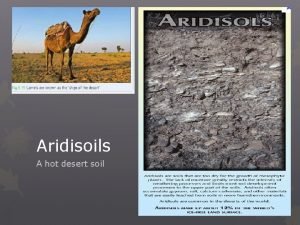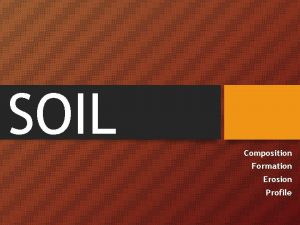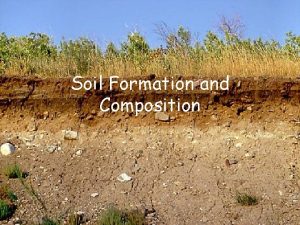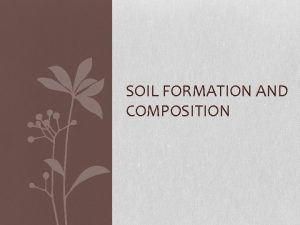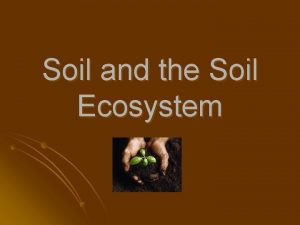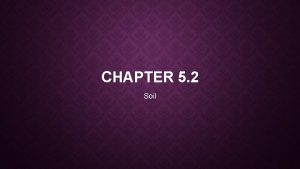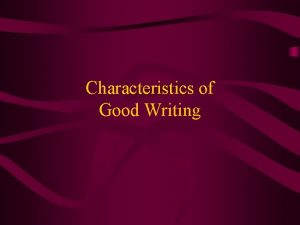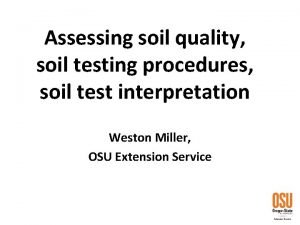Soil Characteristics of Soil Composition good quality soil

![Characteristics of Soil Composition [good quality soil] • Regolith – mineral fragments [45%] • Characteristics of Soil Composition [good quality soil] • Regolith – mineral fragments [45%] •](https://slidetodoc.com/presentation_image_h2/4e6ec410393483c2c9a8f73a1a5f801a/image-2.jpg)











- Slides: 13

Soil
![Characteristics of Soil Composition good quality soil Regolith mineral fragments 45 Characteristics of Soil Composition [good quality soil] • Regolith – mineral fragments [45%] •](https://slidetodoc.com/presentation_image_h2/4e6ec410393483c2c9a8f73a1a5f801a/image-2.jpg)
Characteristics of Soil Composition [good quality soil] • Regolith – mineral fragments [45%] • Humus – organic matter [5%] • Water – [25%] • Air – [25%]

Soil Texture Clay – can’t see or feel particles; drains slowly Silt – small Sand – can see and feel particles; drains quickly Loam – a mixture of textures (best for plant growth) • Soil texture is determined by the size of the particles in the soil. • Soil Structure – how it clumps, is determined by its texture.

Soil Pyramid Used to determine the type of soil. Read Second Read Third Read First

Soil Profiles – Mature Soil 1. O Horizon – living matter (plants) 2. A Horizon - topsoil – – closest to the surface “topsoil” humus most biologic activity 3. B Horizon - subsoil – below A horizon – fine particles washed out of A horizon – lowest limit of biologic activity 4. C Horizon – regolith – between B horizon and parent material – weathered parent material (bedrock)

Factors Affecting Soil Formation 1. Parent Material a. The source of the mineral matter in soil b. Affects the rate of weathering and soil formation c. Affects soil fertility 2. Time – the longer it forms the thicker it becomes

3. Climate a. Hot + wet = thick chemically weathered soil b. Cold + dry = thin mechanically weathered soil c. Too much rain = low nutrients (leached out)

Soil Types by Climate: Pedalfer a. Temperate areas with high rain fall b. Ex: eastern US (forests) c. Iron rich clays – look reddish brown

Soil Types by Climate: Pedocal a. Drier areas b. Ex: western US (prairies) c. Calcite rich – light grayish brown

Soil Types by Climate: Laterite a. Hot wet tropical areas b. Ex: tropical rain forest c. High in iron oxide (rust) – looks orange

4. Organisms a. Plants – source of humus as they decay b. Microorganisms – decompose plants c. Burrowing animals – feed on and mix soil

Soil Erosion Naturally Occurring Sped up due to poor management by Humans

Rates of erosion depend on slope a. Steep + high erosion + little water in soil + few plants = thin soil b. No slope + lots of water + many plants = thick soil c. Slope faces North = cool and wet d. Slope faces South = warm and dry
 Pie chart of soil
Pie chart of soil Good deeds good thoughts
Good deeds good thoughts Good evening good afternoon
Good evening good afternoon Good afternoon animado
Good afternoon animado You are good you are good when there's nothing good in me
You are good you are good when there's nothing good in me Buenas tardes
Buenas tardes Characteristics of aridisols
Characteristics of aridisols Pedalfers
Pedalfers Apes soil lab
Apes soil lab Quality control and quality assurance
Quality control and quality assurance Pmp quality vs grade
Pmp quality vs grade What are quality standards in project management
What are quality standards in project management Ana quality assurance model
Ana quality assurance model Quality improvement vs quality assurance
Quality improvement vs quality assurance






